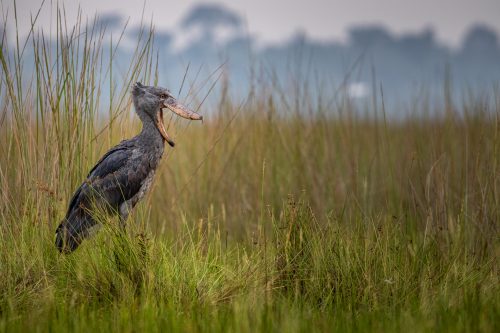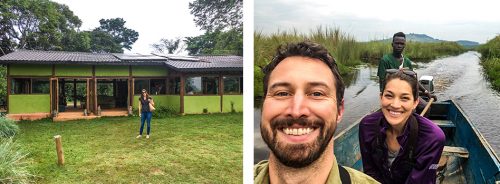
If you’ve ever been dubious about birds being the descendants of dinosaurs, look no further than the shoebill. Just look at it; it’s basically a flying dinosaur.
Even its scientific name, Balaeniceps rex (which literally translates to “King of the Whale Heads”), sounds more like a name reserved for a giant prehistoric reptile than a stork-sized modern-day waterfowl.

It’s a strange bird, and that’s saying something – in a class of animals with more than 10,500 representative species, ranging from hummingbirds to ostriches, it stands out. In fact, for a long time, scientists didn’t know where to place it – was it more closely related to herons, or storks, or pelicans, or . . .? These days, it’s in a monotypic family (meaning its closest living relative is in another family entirely) within the order that contains pelicans and herons.
For all these reasons (it’s a bird, pretty weird, and looks like a dinosaur), plus the fact that it’s a rare and threatened species, (some estimates suggest as few as 5,000 individuals left in the wild) I’ve always wanted to see one. And badly – as in, been at the top of my most-wanted list for years.
And so it was this last February, for our sixth wedding anniversary (thanks for being a good sport, love), that Shan and I went to Uganda for a long weekend getaway to find romance and a bird.

Part of the fun of this journey was the fact that AirKenya had recently launched direct flights from the Mara to Uganda (part of a brilliant plan to directly connect a Mara safari with gorilla-trekking) – which meant that we pretty much walked out of our front door to board a plane at the Angama Airfield and, after a brief stop in Kisumu for immigration, disembarked in Entebbe after about an hour-and-a-half scenic flying time.
From Entebbe, most people would board another short flight to go in search of great apes – but not us. We left the airport to drive to the other side of town and hitch a boatride across a channel, where we were picked up and driven to Nkima Forest Lodge, perched atop a hill overlooking the home of the shoebill, Mabamba Swamp.
Recognized as a Wetland of International Importance by the Ramsar Convention on Wetlands, and an Important Bird Area by Birdlife International, Mabamba has a lot more to offer than just shoebills, but shoebills are what put it on the map as perhaps the world’s most easily accessible site to find these scarce and elusive birds.

But it almost wasn’t so: while a shoebill is opportunistic in what it eats, its preferred food is fish, and local fishermen took exception to that, persecuting the birds to near extirpation. Thankfully, concerned citizens and conservation groups launched a programme to not only educate fishermen, but empower them. Now shoebills are respected and valued within the local community, and many fishermen double as birding guides, earning a respectable income from protecting these gangly fish-eating former dinos.

We found just such a bird guide, Shakul, early one morning and, after paying our conservation fees, were the first out on that day’s shoebill search. We launched the boat down a narrow channel bordered by towering papyrus, and as we motored quietly along, Shakul expertly navigating myriad channels, I couldn’t help but feel that this primordial swamp was just the place to find a dinosaur.

The chances of seeing a shoebill in Mabamba are good, but never guaranteed – it can sometimes take two or three boat rides to find one. But we were lucky – Shakul managed to find one in relatively short order, finally convincing me that these strange creatures do, in fact, exist.
Shoebills are well-known for their persistence when stalking prey, moving at a determinedly glacial pace, with patience and concentration that can last for hours, until striking forth with the speed and agility of a viper. And so it was with our bird – stealthily and unwearyingly creeping along like one of those statue street performers, only once breaking character when an otter burst forth from the water in front of it, spooking it into a short flight.

Although we never did get to witness it catch a fish, it was still a marvel to watch and somehow kept us on the edge of our seats for the better part of two hours. I didn’t want to leave, but a chilly drizzle and the promise of a hot cup of tea back at Nkima Forest Lodge coaxed us back to shore. So we set off for home, water gliding silently beneath us, and left the swamp, and the dinosaurs, behind us.
Filed under: East Africa Travel
Subscribe for Weekly Stories
Comments (4):
17 July 2020
Used to see them on numerous occasions in the reed beds around the outskirts of Homa Bay in the late 70s and even saw one in the reeds in the garden of the Homa Bay hotel when I did a remembrance visit in 95. So I guess if one looks hard enough they can still be found around Homa Bay and Kendu Bay
14 July 2020
How interesting! It sure does look prehistoric. Wonderful shots.

Weddings in the Mara